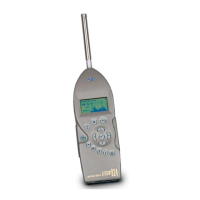D-14 824 Reference Manual 9/29/09
4. Keep microphones away from strong electrical fields.
A microphone measures forces not pressures. We would like
the microphone to measure sound pressure (force per unit
area) instead of sound force. If the pressure is applied
uniformly over the microphone diaphragm a simple constant
(the diaphragm area) relates the two, but if the pressure
varies across the diaphragm the relationship is more
complex. For example, if a negative pressure is applied on
one-half the diaphragm and an equal positive pressure is
applied to the other half, the net force is zero and essentially
no motion of the diaphragm occurs. This occurs at high
frequencies and for specific orientations of the microphone.
Rules:
1. Do not use a microphone at frequencies higher than
specified by the manufacturer; to increase the frequency
response choose smaller microphones.
2. Choose a microphone for
free field or random incidence
to minimize the influence of orientation.
A microphone influences the sound being measured. The
microphone measures very small forces, low level sound can
run about one-billionth of a PSI! Every measurement
instrument changes the thing being measured, and for very
small forces that effect can be significant. When sound
impinges directly on a microphone the incident wave must
be reflected since it cannot pass through the microphone.
This results in the extra force required to reflect the sound
and a microphone output that is higher than would exist if
the microphone were not there. This is more important at
high frequencies and when the microphone is facing the
sound source.
Rules:
1. Do not use a microphone at frequencies higher than
specified by the manufacturer; to increase the frequency
response choose smaller microphones.
2. Choose a microphone for
free field or random incidence
to minimize the influence of orientation.
A microphone measures what is there from any direction:
Most measurements are intended to measure the sound level
of a specific source, but most microphones are not
directional so they measure whatever is there, regardless of
source.
Rules:
1. When making hand-held measurements, keep your body
at right angles to the direction of the sound you are
interested in and hold the meter as far from your body as

